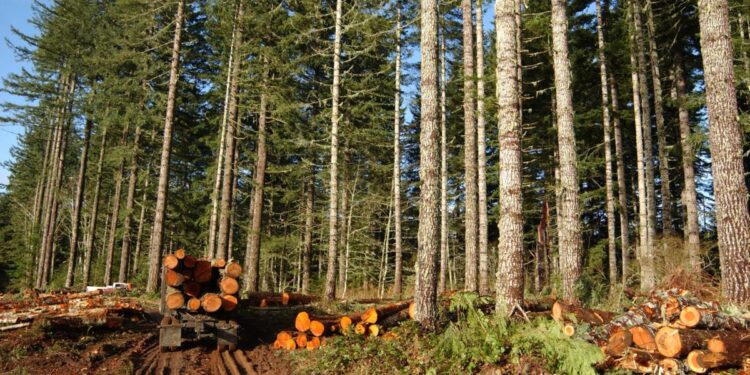Timber Business to Plant 10k Trees
Trees stabilize soil, cool the air, reduce noise levels, and absorb carbon dioxide. They also help to lower residential energy consumption and improve stormwater runoff.
Mr. Merlo has a reputation as something of a rogue in the lumber industry. He has bought forest land when others are selling and fought labor unions when others were negotiating.
Louisiana-Pacific’s Small-Tree Strategy
Across the forest industry, companies have discovered that they need fewer big trees. Trees that take 50 to 100 years to grow are being mowed down after just a few decades by lumber corporations eager to turn the profits from their sale of a raw material whose supply is shrinking.
Mr. Merlo is one of the industry’s leading innovators, and he has been willing to move in directions that others
have not. He has bought forest land when other companies sold it, and he has fought the labor unions while
others were negotiating with them. He flies from sawmill to sawmill, decked out in cowboy boots and leather jacket.
His latest strategy involves growing small trees on farmland and then pulverizing them, mixing in toxic formaldehyde and then pressing them into boards. He argues that his strategy is better for the environment than simply waiting until the big trees are too old to harvest. But critics say the company is simply trying to get around environmental pressures and that it still depends too much on logs from national forests.
Louisiana-Pacific’s Big-Tree Strategy
For most of his career, Louisiana-Pacific President Harry Merlo has been a man willing to go in one direction while the rest of the forest products industry went another. He bought timberland when others were selling and he fought labor unions while other lumber companies were negotiating.
Merlo saw that big trees, which are needed to make solid wood building products such as plywood and floorboards, were disappearing. He argued that environmentalists, worried about the spotted owl and other species, were restricting logging too much.
Merlo began a 10-year campaign to shift the company away from using solid wood and toward engineered wood products that use small bits of wood glued together. He pioneered a product called oriented strand board (OSB), which is made by pressing together flakes of aspen and other small-diameter, fast-growing trees that didn’t have a lot of commercial value in their raw form.
These new products required fewer large trees and could be made on land that would otherwise be used for farming.
Louisiana-Pacific’s Agricultural Strategy
While the company continues to harvest large trees, it also is shifting to more engineered wood products such as I-joists. They make up less than a third of the company’s revenues, but they have higher profit margins than lumber.
Mr. Merlo’s strategy is not to appease environmentalists, but rather to anticipate that their pressure will shift from preserving old trees to preventing companies from cutting young ones too soon. He tries to minimize his
environmental footprint by buying land that others are selling and by expanding into countries like Siberia where
tree growth is faster.
He has also been more aggressive than other timber companies in cutting labor costs. He once led a group of
forest product companies in breaking their contracts with labor unions and decertifying them at some of his
plants. He has even opened a plant in Mexico, where workers are paid only a fraction of what timber workers in
the United States get.
Louisiana-Pacific’s Siberia Strategy
Siberian development requires special forms of state spatial, structural and investment policy and specific measures for developing its unique potential in the form of a microregion economy. This means new technologies (especially IT) and high-tech agro-food complexes based on interregional knowledge and skills spillover.
Currently, Siberian territories are developing primarily according to national goals and objectives (expanding Russia’s geopolitical space by moving East; the defense industry, including the development of the Russian nuclear and space programs; the resource base for domestic industrial enterprises; filling the state budget; etc.).
The interests of Siberian regions and their populations are not adequately taken into account in these processes. This has created a situation in which the Russian government and large business have been carrying out elements of colonial policy towards Siberia, while disregarding its natural and cultural heritage and its long-term potential for development. This must change. You can more.










































